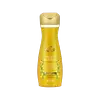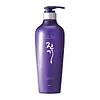What's inside
What's inside
 Key Ingredients
Key Ingredients

 Benefits
Benefits

 Concerns
Concerns

 Ingredients Side-by-side
Ingredients Side-by-side

Water
Skin ConditioningPanax Ginseng Root Extract
EmollientCocamidopropyl Betaine
CleansingSodium C14-18 Olefin Sulfonate
CleansingSodium Lauroyl Methylaminopropionate
CleansingCoptis Japonica Extract
AntimicrobialParfum
MaskingCocamide Mea
EmulsifyingPolyquaternium-22
Lactic Acid
BufferingPhenoxyethanol
PreservativeBetaine
HumectantSalicylic Acid
MaskingPanthenol
Skin ConditioningMenthol
MaskingNiacinamide
SmoothingHouttuynia Cordata Extract
Skin ConditioningGinkgo Biloba Leaf Extract
Skin ConditioningDisodium EDTA
Dipotassium Glycyrrhizate
HumectantButylene Glycol
HumectantLavandula Angustifolia Flower Water
Skin ConditioningGanoderma Lucidum Extract
Skin ProtectingBrassica Napus Seed Oil
EmollientCitrus Paradisi Fruit Extract
Skin ConditioningPinus Sylvestris Cone Extract
MaskingCitrus Limon Fruit Extract
MaskingArtemisia Vulgaris Extract
Skin ConditioningAlcohol
AntimicrobialPyrus Malus Fruit Extract
Skin ConditioningAloe Barbadensis Leaf Extract
EmollientCoix Lacryma-Jobi Ma-Yuen Seed Extract
Skin ConditioningCalendula Officinalis Extract
Skin ConditioningRosmarinus Officinalis Extract
AntimicrobialSalvia Officinalis Extract
AntimicrobialWater, Panax Ginseng Root Extract, Cocamidopropyl Betaine, Sodium C14-18 Olefin Sulfonate, Sodium Lauroyl Methylaminopropionate, Coptis Japonica Extract, Parfum, Cocamide Mea, Polyquaternium-22, Lactic Acid, Phenoxyethanol, Betaine, Salicylic Acid, Panthenol, Menthol, Niacinamide, Houttuynia Cordata Extract, Ginkgo Biloba Leaf Extract, Disodium EDTA, Dipotassium Glycyrrhizate, Butylene Glycol, Lavandula Angustifolia Flower Water, Ganoderma Lucidum Extract, Brassica Napus Seed Oil, Citrus Paradisi Fruit Extract, Pinus Sylvestris Cone Extract, Citrus Limon Fruit Extract, Artemisia Vulgaris Extract, Alcohol, Pyrus Malus Fruit Extract, Aloe Barbadensis Leaf Extract, Coix Lacryma-Jobi Ma-Yuen Seed Extract, Calendula Officinalis Extract, Rosmarinus Officinalis Extract, Salvia Officinalis Extract
Water
Skin ConditioningChrysanthemum Boreale Flower/Leaf/Stem Extract
Skin ConditioningSodium Laureth Sulfate
CleansingSodium Lauryl Sulfate
CleansingRehmannia Glutinosa Root Extract
Skin ConditioningThuja Orientalis Leaf Extract
AntioxidantArtemisia Vulgaris Extract
Skin ConditioningCocamidopropyl Betaine
CleansingDimethicone
EmollientGleditsia Japonica Fruit Extract
Skin ConditioningMorus Alba Bark Extract
Skin ConditioningEclipta Prostrata Extract
Skin ConditioningPEG-7 Glyceryl Cocoate
EmulsifyingAcorus Calamus Rhizome Water
Skin ConditioningParfum
MaskingCnidium Officinale Root Extract
Skin ConditioningCocamide Mea
EmulsifyingDecylene Glycol
Skin ConditioningSodium Chloride
MaskingCarbomer
Emulsion StabilisingSodium Cocoyl Alaninate
Triethanolamine
BufferingPEG-10
HumectantGuar Hydroxypropyltrimonium Chloride
Skin ConditioningPropylene Glycol
HumectantMenthol
MaskingHydroxyacetophenone
AntioxidantLactobacillus/Centella Asiatica/Gleditsia Sinensis Thorn/Houttuynia Cordata Extract/Phellodendron Amurense Bark/Polygonum Cuspidatum Root/Prunella Vulgaris/Torilis Japonica Extract Ferment Filtrate
Skin ConditioningPanax Ginseng Root Extract
EmollientDisodium EDTA
Panthenol
Skin ConditioningButylene Glycol
HumectantCitric Acid
BufferingLauramine Oxide
CleansingOak Vinegar
Skin ConditioningHydrolyzed Keratin
HumectantPortulaca Oleracea Extract
Skin ConditioningSodium Benzoate
MaskingPhenoxyethanol
PreservativeLinalool
PerfumingAlpha-Isomethyl Ionone
PerfumingLimonene
PerfumingHexyl Cinnamal
PerfumingCitronellol
PerfumingWater, Chrysanthemum Boreale Flower/Leaf/Stem Extract, Sodium Laureth Sulfate, Sodium Lauryl Sulfate, Rehmannia Glutinosa Root Extract, Thuja Orientalis Leaf Extract, Artemisia Vulgaris Extract, Cocamidopropyl Betaine, Dimethicone, Gleditsia Japonica Fruit Extract, Morus Alba Bark Extract, Eclipta Prostrata Extract, PEG-7 Glyceryl Cocoate, Acorus Calamus Rhizome Water, Parfum, Cnidium Officinale Root Extract, Cocamide Mea, Decylene Glycol, Sodium Chloride, Carbomer, Sodium Cocoyl Alaninate, Triethanolamine, PEG-10, Guar Hydroxypropyltrimonium Chloride, Propylene Glycol, Menthol, Hydroxyacetophenone, Lactobacillus/Centella Asiatica/Gleditsia Sinensis Thorn/Houttuynia Cordata Extract/Phellodendron Amurense Bark/Polygonum Cuspidatum Root/Prunella Vulgaris/Torilis Japonica Extract Ferment Filtrate, Panax Ginseng Root Extract, Disodium EDTA, Panthenol, Butylene Glycol, Citric Acid, Lauramine Oxide, Oak Vinegar, Hydrolyzed Keratin, Portulaca Oleracea Extract, Sodium Benzoate, Phenoxyethanol, Linalool, Alpha-Isomethyl Ionone, Limonene, Hexyl Cinnamal, Citronellol
Ingredients Explained
These ingredients are found in both products.
Ingredients higher up in an ingredient list are typically present in a larger amount.
Artemisia Vulgaris Extract is more commonly known as the common mugwort. It has strong antioxidant properties and helps soothe irritation.
Antioxidants protect skin from damage and the signs of aging.
This plant contains the compounds saponins, glycosides, flavanoids, protein, triterpenoids.
The common wugwort has been used in traditional Indian, Chinese, and European medicines to treat gastrointestinal diseases.
Learn more about Artemisia Vulgaris ExtractButylene Glycol (or BG) is used within cosmetic products for a few different reasons:
Overall, Butylene Glycol is a safe and well-rounded ingredient that works well with other ingredients.
Though this ingredient works well with most skin types, some people with sensitive skin may experience a reaction such as allergic rashes, closed comedones, or itchiness.
Learn more about Butylene GlycolWe don't have a description for Cocamide Mea yet.
Cocamidopropyl Betaine is a fatty acid created by mixing similar compounds in coconut oil and dimethylaminopropylamine, a compound with two amino groups.
This ingredient is a surfactant and cleanser. It helps gather the dirt, pollutants, and other impurities in your skin to be washed away. It also helps thicken a product and make the texture more creamy.
Being created from coconut oil means Cocamidopropyl Betaine is hydrating for the skin.
While Cocamidopropyl Betaine was believed to be an allergen, a study from 2012 disproved this. It found two compounds in unpure Cocamidopropyl Betaine to be the irritants: aminoamide and 3-dimethylaminopropylamine. High-grade and pure Cocamidopropyl Betaine did not induce allergic reactions during this study.
Learn more about Cocamidopropyl BetaineDisodium EDTA plays a role in making products more stable by aiding other preservatives.
It is a chelating agent, meaning it neutralizes metal ions that may be found in a product.
Disodium EDTA is a salt of edetic acid and is found to be safe in cosmetic ingredients.
Learn more about Disodium EDTAMenthol is a compound found in mint plants, such as peppermint. In its pure form, it is a clear crystalline substance.
Menthol is known for its cooling sensation; however, the cooling is actually from your skin being sensitized. Menthol can worsen rosacea. We recommend speaking with a professional if you have concerns.
Menthol also has antimicrobial properties.
Learn more about MentholGinseng root is a well-loved ingredient in Asian skincare for good reason. It hydrates the skin, soothes irritation, and helps even out skin tone.
In traditional East Asian medicine, ginseng has been used for centuries both as food and as a healing remedy, and modern research continues to confirm its skin benefits.
One of the standout features of ginseng is its ability to improve blood circulation and oxygen delivery to the skin, bringing a fresh supply of nutrients to support overall skin health. It also has antioxidant and anti-inflammatory properties. This helps to protect your skin against damage from UV exposure, pollution, and daily stress.
Additionally, studies suggest that ginseng may help reduce hyperpigmentation by inhibiting tyrosinase, the enzyme involved in melanin production.
There are different types of ginseng used in skincare, and while they all share core benefits, their potency can vary.
Most products use fresh or white ginseng because it’s more affordable. However, red ginseng, produced by steaming the root, contains higher levels of ginsenosides, which are compounds with proven anti-aging effects. These ginsenosides help reduce the appearance of wrinkles and improve skin elasticity.
Note: All forms of ginseng are listed simply as “Panax ginseng” in ingredient lists. We recommend reaching out to the brand if you have questions about which type of ginseng is used in their ingredients.
For general antioxidant benefits, any ginseng extract will do, but for wrinkle care or firmer skin, red or fermented ginseng is often more effective.
In short, ginseng is a powerhouse ingredient that supports hydration, radiance, and resilience.
Learn more about Panax Ginseng Root ExtractPanthenol is a common ingredient that helps hydrate and soothe the skin. It is found naturally in our skin and hair.
There are two forms of panthenol: D and L.
D-panthenol is also known as dexpanthenol. Most cosmetics use dexpanthenol or a mixture of D and L-panthenol.
Panthenol is famous due to its ability to go deeper into the skin's layers. Using this ingredient has numerous pros (and no cons):
Like hyaluronic acid, panthenol is a humectant. Humectants are able to bind and hold large amounts of water to keep skin hydrated.
This ingredient works well for wound healing. It works by increasing tissue in the wound and helps close open wounds.
Once oxidized, panthenol converts to pantothenic acid. Panthothenic acid is found in all living cells.
This ingredient is also referred to as pro-vitamin B5.
Learn more about PanthenolParfum is a catch-all term for an ingredient or more that is used to give a scent to products.
Also called "fragrance", this ingredient can be a blend of hundreds of chemicals or plant oils. This means every product with "fragrance" or "parfum" in the ingredients list is a different mixture.
For instance, Habanolide is a proprietary trade name for a specific aroma chemical. When used as a fragrance ingredient in cosmetics, most aroma chemicals fall under the broad labeling category of “FRAGRANCE” or “PARFUM” according to EU and US regulations.
The term 'parfum' or 'fragrance' is not regulated in many countries. In many cases, it is up to the brand to define this term.
For instance, many brands choose to label themselves as "fragrance-free" because they are not using synthetic fragrances. However, their products may still contain ingredients such as essential oils that are considered a fragrance by INCI standards.
One example is Calendula flower extract. Calendula is an essential oil that still imparts a scent or 'fragrance'.
Depending on the blend, the ingredients in the mixture can cause allergies and sensitivities on the skin. Some ingredients that are known EU allergens include linalool and citronellol.
Parfum can also be used to mask or cover an unpleasant scent.
The bottom line is: not all fragrances/parfum/ingredients are created equally. If you are worried about fragrances, we recommend taking a closer look at an ingredient. And of course, we always recommend speaking with a professional.
Learn more about ParfumPhenoxyethanol is a preservative that has germicide, antimicrobial, and aromatic properties. Studies show that phenoxyethanol can prevent microbial growth. By itself, it has a scent that is similar to that of a rose.
It's often used in formulations along with Caprylyl Glycol to preserve the shelf life of products.
Water. It's the most common cosmetic ingredient of all. You'll usually see it at the top of ingredient lists, meaning that it makes up the largest part of the product.
So why is it so popular? Water most often acts as a solvent - this means that it helps dissolve other ingredients into the formulation.
You'll also recognize water as that liquid we all need to stay alive. If you see this, drink a glass of water. Stay hydrated!
Learn more about Water